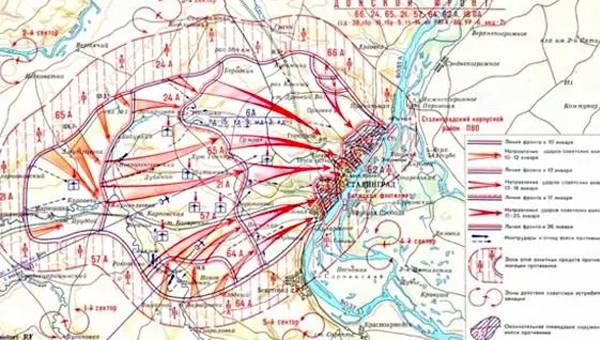
Photo: https://pikabu.ru/
Exactly 80 years ago, on January 10, 1943, the Red Army began the Ring operation, whose goal was to eliminate the 6th Army of the Wehrmacht, encircled in Stalingrad.
The Soviet troops planned to strike two blows, from the north and south directions, thereby cutting ‘the Stalingrad cauldron’ and breaking the enemy in parts. It was decided at the Supreme Command headquarters that the operation would be conducted by the Don front. Its commander, General Konstantin Rokossovsky, and chief of staff, General Mikhail Malinin, were charged with preparing the offensive, for which several additional armies were sent to the area of Stalingrad.
Shortly before the beginning of the Ring operation parliamentarians were sent to the Germans from our side, who conveyed to them a surrender proposal to avoid additional bloodshed. However, the commander of the Sixth Army (which numbered 250,000 people, armed with more than 4,000 guns, 300 tanks and 100 planes), Field Marshal Friedrich Paulus, fulfilling Hitler's order “to hold Stalingrad at any cost,” rejected all offers of the Soviet High Command.
Then, after an artillery preparation that lasted about an hour, the Red Army went on the offensive, engaging in a fierce battle. Before the beginning of the Operation Ring about 200,000 additional Red Army soldiers, 7,000 guns, 260 tanks and 300 planes were transferred to Stalingrad. It is noteworthy that outside the city the line was held by the 21st, 24th, 57th, 65th and 66th armies, forming a “cauldron,” stretching to the west for 40-60 km.
Despite the disadvantage the German Nazi troops fiercely defended, and in the first days of the operation the Red Army did not achieve much success. On the third day of fierce fighting the Soviet troops managed to reach the western edge of the “cauldron” to the Rossosh river, moreover, the German defenses were also broken in other parts.
On January 18, under the onslaught of the Red Army, the “cauldron” was reduced more than twice, the Nazis retreated, and they had numerous cases of starvation and frostbite. For the above reasons, Paulus asked Hitler to declare surrender, but his request was rejected.
After a short respite, the Red Army began the offensive again, and by January 25, the area of the “cauldron” was already 100 square kilometers. Nazis were confined to Volga, and with losses of airfields they lost the last connection with Reich. Their grouping was already divided into two “cauldrons,” after which the storming of the city and street battles began, during which the German headquarters was also surrounded.
After the negotiations, in which, incidentally, Paulus did not participate (apparently, in order not to be involved in the surrender, having entrusted them to General Friedrich Roska), he surrendered, becoming the first captured German field marshal in the history of the Wehrmacht. This was followed by the surrender of the entire German Southern Group, although the Northern Group, led by General Karl Stecker, still continued fighting. However, on February 2 it also laid down its arms, being on the verge of complete destruction.
Let us recall that during the Ring operation the Nazis lost about 140,000 people killed, more than 90,000 were taken prisoner. This operation became the last part of Stalingrad battle, and after this defeat in the south of Russia Germans had to urgently withdraw their troops from the Caucasus. After the victorious completion of Operation Ring, the situation on the fronts of the Second World War changed dramatically. It was from the banks of the Volga the Red Army launched a large-scale counteroffensive, which ended in early May 1945 in Berlin.
